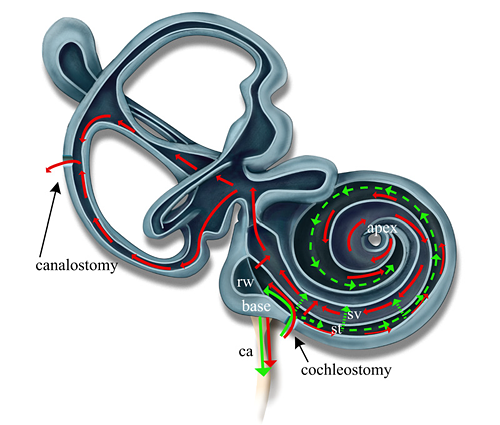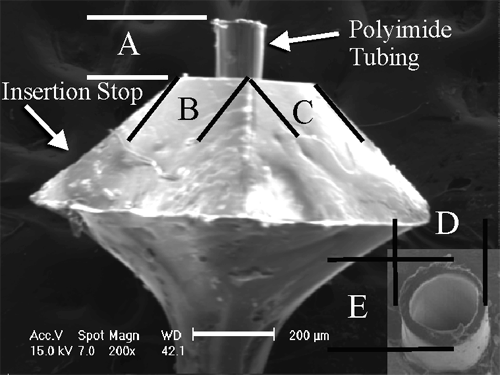
Discovery, Prevention, Therapeutics. One of the Global Center's main R&D strategies is to combine the knowledge and practices of multiple scientific and clinical research disciplines to attack the highly prevalent, complex communication and biomedical problems of hearing impairment, deafness, age-related hearing loss, communication systems, speech perception, and voice quality. These multiple disciplines include audiology, bioengineering, biochemistry, biomedical imaging, cellular and molecular biology, electrical engineering, electrophysiology, gene therapy, genetics, microsystems engineering, neurophysiology, neuroanatomy, psychoacoustics, signal processing, speech science, and voice science.
Representative Projects
Drug Delivery to the Inner Ear
The Frisina Lab at the Global Center for Hearing and Speech Research at the University of South Florida combines the disciplines of biomedical engineering, neuroscience, acoustical engineering, research audiology and sensory psychology for research and development projects to understand and treat hearing loss and deafness. Research program goals include developing therapeutic interventions for deafness and age-related hearing and balance problems using microsystems engineering, micro-fluidics and neurophysiology paradigms. A systems analysis approach is taken to understanding neurophysiological processing at different levels of the auditory system, from the cochlea (auditory portion of the inner ear) to the brain (central auditory system). For example, sensory processing problems occur in both the inner ear and the parts of the brain used for hearing in cases of age-related hearing loss. Major themes of these lines of neuroengineering research are aimed at developing novel therapies for preventing, delaying or treating cases of environmentally-induced hearing loss, i.e. noise exposure, age-related hearing deficits and congenital deafness and balance problems. Program goals focus on identifying and understanding normal and abnormal auditory processing; methods for ameliorating such deficits, including the development of hardware and software solutions for hearing related pathologies. Development of novel biomedical engineering systems for drug delivery to the inner ear are currently being conducted in collaboration with Dr. David Borkholder, Professor of Microsystems Engineering, Rochester Institute of Technology, Rochester NY.

Figure 1 Legend: Theoretical flow path within the cochlea and vestibular system for two surgical Micro-surgical approaches to the mouse inner ear - cochlea. Pressure driven flow is depicted with solid lines while dotted lines represent diffusion mechanisms. Cochleostomy-only (Green) results in pressure driven outflow through the cochlear aqueduct (ca) and diffusion-driven transport from base to apex and between scalae. Cochleostomy-plus-canalostomy (Red) results in pressure driven flow through the cochlear aqueduct, between scalae, and from base to apex in scala tympani (st), through the helicotrema, and from apex to base in scala vestibuli (sv), and then through the vestibular system. Modeling of these infusion approaches with FluidSim was constrained to a single fluidic exit placed at either the ca or the base of sv. (From Borkholder et al., 2010; Fig. 2)

Figure 2 Legend: Scanning electron micrograph – SEM, of micro-cannula showing critical dimensions of integrated insertion stop. Inset is tubing tip (magnification 320x). Insertion Depth = A (μm): Avg = 175.7, Std Dev = 1.1, Max = 178.4, Min = 173.4 (19 samples, three molds). Interface Contact Area = B*C (μm2): Avg = 62,383. Std Dev = 290, Max = 62,550, Min = 62,048 (3 samples, one mold). Out of Round = D/E within part out of round: Avg = 1.03, Std Dev =0.02, Max = 1.07, Min = 1.00 (20 samples, three molds). (From Johnson et al., 2007; Fig. 4)

Figure 3 Legend: Four chamber peristaltic pump concept with anemometer coupled to 140 μm O.D. capillary tubing. Chambers: 400 μm in diameter, channel width: 100 μm. Overall finished device dimensions anticipated to be 5 mm x 2 mm x 1mm including actuation and RF power coupling (not shown). (From Johnson et al., 2010; Fig. 1)
References:
Borkholder, D.A., Zhu, X., Hyatt, B.T., Archilla, A.S., Livingston, W.J., Frisina, R.D. (2010) Murine Intracochlear Drug Delivery: Reducing Concentration Gradients within the Cochlea. Hearing Res. 268: 2-11. (PMID: 20451593; PMCID: PMC2933796). Download PDF
Johnson, D.G., Frisina, R.D., Borkholder, D.A. (2011) In-Plane Biocompatible Microfluidic Interconnects for Implantable Microsystems. IEEE Transactions on Biomedical Engineering. 58: 943-948. (PMID: 21147591) Download PDF
Johnson, D.G., Waldron, M.J., Frisina, R.D., Borkholder, D.A. (2010) Implantable Micropump Technologies for Murine Intracochlear Infusions. IEEE Engineering in Medicine and Biology Society. 6441-6444. (PMID: 21096713). Download PDF
Johnson, D.G., Zhu, X., Frisina, R.D., Borkholder, D.A. (2007) Micro-Molded Cannulae for Intracochlear Infusions in Small Rodents. 29th IEEE EMBS Annual International Conf. Proc.: Medicine & Biology, 6616-6619. Download PDF


